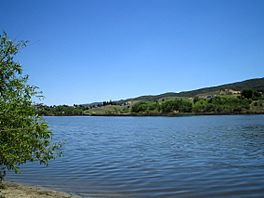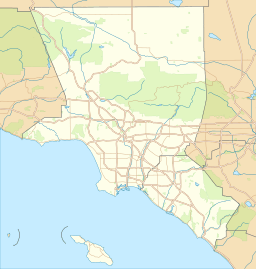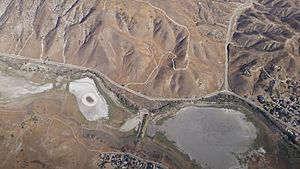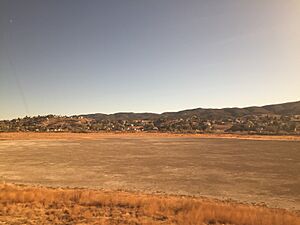Elizabeth Lake (Los Angeles County, California) facts for kids
Quick facts for kids Elizabeth Lake |
|
|---|---|

In 2008
|
|
| Location | Sierra Pelona Mountains, Angeles National Forest, Los Angeles County, California |
| Coordinates | 34°39′57″N 118°24′09″W / 34.6658189°N 118.4025808°W |
| Type | Sag pond |
| Basin countries | United States |
| Surface elevation | 973 m (3,192 ft) |
| Settlements | Elizabeth Lake, Lake Hughes |
Elizabeth Lake is a natural lake in southern California. It sits right on the San Andreas Fault. This fault is a huge crack in the Earth's crust. The lake is located in the northern Sierra Pelona Mountains in Los Angeles County.
Contents
What is Elizabeth Lake Like?
Elizabeth Lake is about 984 meters (3,228 feet) above sea level. It is found inside the Angeles National Forest. This lake usually has water all year round. However, during very dry years, it can completely dry up. The lake is south of the western Antelope Valley.
Elizabeth Lake is a special type of lake called a "sag pond." Sag ponds form when the Earth's tectonic plates move along a fault line. The ground sinks, creating a basin that fills with water. Other sag ponds nearby include Hughes Lake and the Munz Lakes. These lakes are all part of the northern Santa Clara River system.
The small town of Elizabeth Lake is right on the shore. It is part of the larger Lake Hughes community.
A Look Back: History of Elizabeth Lake
How Did Elizabeth Lake Get Its Name?
Back in 1780, a Spanish explorer and priest named Junipero Serra visited the lake. He called it La Laguna de Diablo, which means "Devil's Lake." This was because some local people believed a creature lived in the lake. They said it looked like a dragon with leathery wings and scaly skin. This creature later became known as the Elizabeth Lake Monster.
Later, around 1834, the lake was briefly called La Laguna de Liebre, or "Rabbit Lake." In the 1840s, it got another name: La Laguna de Chico Lopez. This name honored Francisco "Chico" Lopez, who grazed his cattle near the lake.
Native American History Near the Lake
Elizabeth Lake was an important spot for different Native American tribes. It marked the border between the lands of the Tataviam, Kitanemuk, and Serrano tribes. The Tataviam people might have called the lake Kivarum. A village of the Vanyume (desert Serrano) tribe, called Tsivung, was also located close to the lake.
Early Roads and Trails
In the 1780s, a main road connected southern and northern Spanish California. It was called El Camino Viejo a Los Ángeles, meaning "the Old Road to Los Angeles." This road was an important way to travel inland. It was an alternative to the coastal trail, El Camino Real.
Locally, this old road went through the Sierra Pelona Mountains. It passed by Elizabeth Lake and then continued northwest. Another important route branched off from El Camino Viejo at Elizabeth Lake. This route went north, crossed the western Antelope Valley, and then went over the Tehachapi Mountains. This path was very important for connecting the southern part of the state to the goldfields in the north, especially from 1849 to 1854.
Elizabeth Lake in the United States Era
In the early 1850s, many California grizzly bears lived around Elizabeth Lake. There were so many that raising cattle was very difficult.
Later, in 1854, the main road to the San Joaquin Valley changed. It moved to the Stockton - Los Angeles Road, using the Fort Tejon Pass. The Butterfield Overland Mail route also passed near Elizabeth Lake.
The first building at the lake was an adobe house built by Miguel Ortiz. He was a muleteer, someone who drives mules.
Education Around the Lake
In 1869, the Los Angeles County Board of Supervisors created the Elizabeth Lake School District. This district served the area and had the only school between Los Angeles and Bakersfield. Children from Lake Hughes, Elizabeth Lake, and Green Valley still attend schools in this district today. The original wooden schoolhouse from 1869 was replaced by an adobe building in the early 1930s.
How Lake Hughes Got Its Name
In 1924, a person named Judge Hughes renamed the sag pond west of Elizabeth Lake. He called it Lake Hughes. He then developed a fun resort area around this new lake.
Recent Times
In 2010, a large wildfire called the Crown Fire burned over 13,918 acres in the area. It destroyed 10 homes. Elizabeth Lake was dry from 2013 due to a long drought. However, after the heavy rains in the winter of 2022-2023, water has returned to the lake. It is now almost full again.
Images for kids









